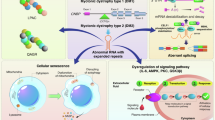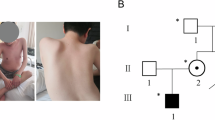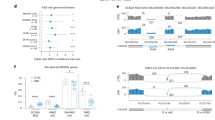Abstract
Trinucleotide repeat expansions (TREs) are a recently described class of mutations characterized by a change in the size of the genomic fragment due to amplification of the repeated unit. A number of diseases have been attributed to TRE, including Huntington disease and myotonic dystrophy (DM; refs 1–3), but attempts at genetic therapy have yet to prove successful. A potential therapeutic approach would be to repair the expanded repeat using the trans-splicing ability of group I intron ribozymes4. We have used DM as a model to test this hypothesis. A group I intron ribozyme (DMPK-RZ1) was designed to modify the TRE at the 3′ end of the human myotonic dystrophy protein kinase (DMPK) transcript5–8. DMPK-RZ1 was shown to ligate a small DMPK mRNA fragment, contained within the ribozyme, to a simple DMPK-target RNA in vitro. It also modified a larger target transcript, leading to replacement of twelve repeats with five repeats, both in vitro and in mammalian cells. Finally, this ribozyme successfully replaced the 3′ end of endogenous DMPK mRNA in fibroblasts with a different 3′ region. Ribozyme-mediated RNA repair may thus form a novel therapeutic strategy for diseases associated with repeat expansions.
This is a preview of subscription content, access via your institution
Access options
Subscribe to this journal
Receive 12 print issues and online access
$259.00 per year
only $21.58 per issue
Buy this article
- Purchase on SpringerLink
- Instant access to full article PDF
Prices may be subject to local taxes which are calculated during checkout
Similar content being viewed by others
References
Ashley, C.T., Jr. & Warren, S.T. Trinucleotide repeat expansion and human disease. Annu. Rev. Genet. 29, 703–728 (1995).
Bates, G. & Lehrach, H. Trinucleotide repeat expansions and human genetic disease. Bioessays 16, 277–284 (1994).
Timchenko, L.T. & Caskey, C.T. Trinucleotide repeat disorders in humans: discussions of mechanisms and medical issues. FASEB J. 10, 1589–1597 (1996).
Sullenger, B.A. & Cech, T.R. Ribozyme-mediated repair of defective mRNA by targeted trans-splicing. Nature 371, 619–622 (1994).
Davies, K.E. et al. Linkage analysis of myotonic dystrophy and sequences on chromosome 19 using a cloned complement 3 gene probe. J. Med. Genet. 20, 259–263 (1983).
Buxton, J. et al. Detection of an unstable fragment of DNA specific to individuals with myotonic dystrophy. Nature 355, 547–548 (1992).
Brook, J.D. et al. Molecular basis of myotonic dystrophy: expansion of a trinucleotide (CTG) repeat at the 3′ end of a transcript encoding a protein kinase family member. Cell 68, 799–808 (1992).
Mahadevan, M. et al. Myotonic dystrophy mutation: an unstable CTG repeat in the 3′ untranslated region of the gene. Science 255, 1253–1255 (1992).
Harper, P.S. Myotonic Dystrophy. (WB Saunders, Phildelphia, 1989).
Shelbourne, P. & Johnson, K. Myotonic dystrophy: another case of too many repeats? Hum. Mutat. 1.183–189 (1992).
Tsilfidis, C., MacKenzie, A.E., Mettler, G., Barcelo, J. & Korneluk, R.G. Correlation between CTG trinucleotide repeat length and frequency of severecongenital myotonic dystrophy. Nature Genet. 1, 192–195 (1992).
Cech, T.R., Zaug, A.J. & Grabowski, P.J. In vitro splicing of the ribosomal RNA precursor of Tetrahymena: involvement of a guanosine nucleotide in the excision of the intervening sequence. Cell 27, 487–496 (1981).
Guerrier-Takada, C. & Altman, S. Catalytic activity of an RNA molecule prepared by transcription in vitro. Science 223, 285–286 (1984).
Rossi, J.J., Controlled, targeted, intracellular expression of ribozymes: progress and problems. Trends Biotech. 13, 301–306 (1995).
Birikh, K.R., Heaton, P.A. & Eckstein, F. The structure, function and application of the hammerhead ribozyme. Eur. J. Biochem. 245, 1–16 (1997).
Kiehntopf, M., Esquivel, E.L., Brach, M.A. & Herrmann, F. Clinical applications of ribozymes. Lancet 345, 1027–1031 (1995).
Kilpatrick, M.W. et al. Delivery of a hammerhead ribozyme specifically down-regulates the production of fibrillin-1 by cultured dermal fibroblasts. Hum. Mol. Genet. 5, 1939–1944 (1996).
Ohta, Y., Kijima, H., Ohkawa, T., Kashani-Sabet, M. & Scanlon, K.J. Tissue-specific expression of an anti-ras ribozyme inhibits proliferation of human malignant melanoma cells. Nucleic Acids Res. 24, 938–942 (1996).
Sarver, N. et al. Ribozymes as potential anti-HIV-1 therapeutic agents. Science 247, 1222–1225 (1990).
Cech, T.R. Self-splicing of group I introns. Annu. Rev. Biochem. 59, 543–568 (1990).
Jones, J.T., Lee, S.W. & Sullenger, B.A. Tagging ribozyme reaction sites to follow trans-splicing in mammalian cells. Nature Med. 2, 643–648 (1996).
Carango, P., Noble, J.E., Marks, H.G. & Funanage, V.L. Absence of myotonic dystrophy protein kinase (DMPK) mRNA as a result of a triplet repeat expansion in myotonic dystrophy. Genomics 18, 340–348 (1993).
Young, B., Herschlag, D. & Cech, T.R. Mutations in a nonconserved sequence of the Tetrahymena ribozyme increase activity and specificity. Cell 67, 1007–1019 (1991).
Johnson, K.J. et al. Is myotonic dystrophy a single-gene disorder? Biochem. Soc. Trans. 24, 510–513 (1996).
Hamshere, M.G. & Brook, J.D. Myotonic dystrophy, knockouts, warts and all. Trends Genet. 12, 332–334 (1996).
Jansen, G. et al. Abnormal myotonic dystrophy protein kinase levels produce only mild myopathy in mice. Nature Genet. 13, 316–324 (1996).
Reddy, S. et al. Mice lacking the myotonic dystrophy protein kinase develop a late onset progressive myopathy. Nature Genet. 13, 325–334 (1996).
Klesert, T.R., Otten, A.D., Bird, T.D. & Tapscott, S.J. Trinucleotide repeat expansion at the myotonic dystrophy locus reduces expression of DMAHP. Nature Genet. 16, 402–106 (1997).
Davis, B.M., McCurrach, M.E., Taneja, K.L., Singer, R.H. & Housman, D.E. Expansion of a CUG trinucleotide repeat in the 3′ untranslated region of myotonic dystrophy protein kinase transcripts results in nuclear retention of transcripts. Proc. Natl. Acad. Sci. USA 94, 7388–7393 (1997).
Shaw, D.J. et al. Genomic organization and transcriptional units at the myotonic dystrophy locus. Genomics 18, 673–679 (1993).
Author information
Authors and Affiliations
Corresponding author
Rights and permissions
About this article
Cite this article
Phylactou, L., Darrah, C. & Wood, M. Ribozyme-mediated trans-splicing of a trinucleotide repeat. Nat Genet 18, 378–381 (1998). https://doi.org/10.1038/ng0498-378
Received:
Accepted:
Issue date:
DOI: https://doi.org/10.1038/ng0498-378
This article is cited by
-
Targeted Regression of Hepatocellular Carcinoma by Cancer-Specific RNA Replacement through MicroRNA Regulation
Scientific Reports (2015)
-
Validation of tissue-specific promoter-driven tumor-targeting trans-splicing ribozyme system as a multifunctional cancer gene therapy device in vivo
Cancer Gene Therapy (2009)
-
In Vivo Reprogramming of hTERT by Trans-splicing Ribozyme to Target Tumor Cells
Molecular Therapy (2008)



